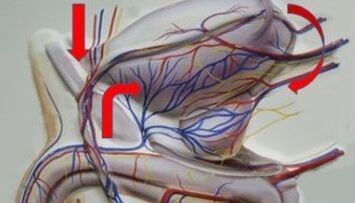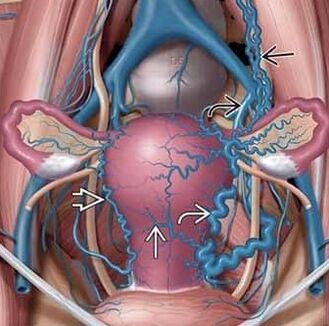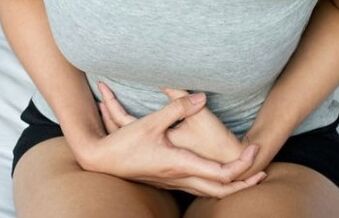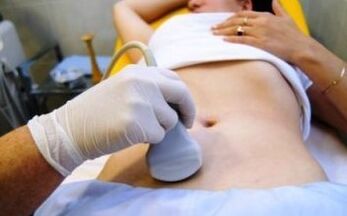The varicose veins of the pelvis (WMMW) or chronic pelvic pain syndrome are still an exotic disease with fuzzy diagnostic boundaries for many doctors.
This explains the fact that some doctors "do not notice" this disorder for their patients for a long time, while others make this diagnosis to almost every second person who suffer from a constant inexplicable pain in the lower abdomen.

In the meantime, the quality of the patient's further life, his ability to enjoy the intimate side of relationships with a loved one and the ability to continue his family, largely depends on the timely detection of the varicose veins, depends largely.
Description of the disease, of its prevalence, statistical data
The phenomenon of chronic pelvic pain has been known to doctors for a long time. But only relatively recently has it become the reason that is most likely known: varicose veins of the pelvis. This is a diseaseWas described for the first time in 1975And still not well studied well.
It is very likely that this pathology develops according to the following algorithm:
- The venous plexus in the basin is a complex formation, which includes both large vascular trunks and smaller veins that extend from them. At the same time, the venous system of the small basin in men and women differs in its structure, which determines the sexual specifications of the disease - VRVMTIt is much more common in the weaker sex representatives.
- Due to ships squeezes, complete or partial clogging of the venous channel, the changes in the tone of the vascular walls are disturbed by the outflow of blood with deep pelvic veins.
- Consequently, the veins cease to perform their functions in full:The lack of venous valves progressesAnd a normal flow of blood is disturbed.
- In the pelvic veins, the stagnant phenomena associated with the reverse blood launched through the vessels begin - this causes the expansion of the veins and the development of varicose veins.

The symptoms of varicose veins (varicose) of the veins of the interior organs of the pelvis are much more common in women of reproductive age than in men. At the same time, ovarian veins ("ovary") suffer more often - in 85% of cases.
The main symptom is the pain that is recorded in over 90% of patients. But the prevalence of this disease has not yet been clarified among the population: according to several studies, it is from 6 to 80%. Such a great race in the "testimony" is explained only by the insufficient qualifications of diagnostic doctors during diagnosis.
Causes and risk factors
The causes of the pelvic varicose veins are any change in the body that can cause the launch of the pathological mechanism of this disease:
- inguinal hernia
- tumor in the pelvis
- Increase pressure in the abdominal cavity due to constipation
- Pregnancy and childbirth
- Gynecological diseases (uterine curve, ovarian cysts)
- Connective tissue diseases, in particular its dysplasia
- stagnant phenomena in the vessels of the pelvis associated with lower sex life
- Hereditary predisposition and congenital weakness of the venous walls
- Long -term use of oral contraceptives
- Propensity for thrombosis
Vrvmt high risk factors are:
- Tesse physical work;
- insufficiently regular or unsatisfactory sex life;
- abuse in intimate life from an interrupted sexual intercourse;
- A large number of pregnancies and childbirth;
- frequent gynecological diseases;
- contraception with hormonal drugs;
- hormonal malfunctions in the body;
- Hypodynamia.
Classification and phases of varicose veins
In the medical environment, the conditional separation of VRVMT is accepted by the nature of the course in varicose veins of the horse and external genitalia (for example, Labia) and Plera Venosa syndrome.
This classification has no practical meaning, since thenIn most cases, patients both have these formsAt the same time, how to behave with each other.
You can also find a classification of the disease with the main cause of its appearance. In this regard, VRVMT is divided into:
- Primary- caused by the unsatisfactory work of the venous valves;
- secondary- develops as a complication of existing inflammatory, gynecological or oncological diseases of the internal organs.

What is dangerous and if there will be consequences
This type of vascular pathologyit cannot be called a fatal disease. Discovered in time, it lends itself well to medical correction. But the whole problem is that finding it is not that simple. The insufficient knowledge of the disease and the low awareness of most diagnostic doctors play a role in this.
So it turns out that patients have suffered from this disorder for years without even suspecting it. And in their body, in the meantimeThere are a series of irreversible changes:
- Varicosis progresses, adjacent areas are included in the pathological process: the expansion of the veins of the reproductive organs (for example, the varicose veins of the penis appear), the perineum and the lower ends.
- The persistent dysfunction of the internal genital organs appears, whichIt can lead to infertility or inability to bear pregnancyIn women.
- Against the background of pain syndrome, various psycho -emotional disorders develop for the type of neurastenia.
- Due to chronic pain, aggravating during intimacy, a person can completely abandon sex.
- The rarest and at the same time the most serious complications of the varicose pelvic veins are considered thrombosis of the veins and thromboembolia of the lungs. Theymeet in about 5% of cases, but always fatal.
Diagnostics
According to American researchers, in the early 2000s, only 2% of patients with Vrvmt initially made the correct diagnosis. Sometimes a consequence of a diagnostic error was the removal of cleaning organs in women, although this could be avoided if they were usedThe most accurate methods to diagnose varicose pelvic veins:
- Study to ultrasound and dopplerographic of the veins- allows you to suspect varicose veins;
- Phlebography- invasive study, which allows high precision to determine the presence and the degree of illness;
- Laparacopia- In case of differential diagnosis of VRVMT from the differential diagnosis of the symptoms of gynecological diseases (endometriosis, myoma, affected).
- Selective ovarography- The study of the state of the veins by introducing a matter of contrast is considered the most objective diagnostic method.
- Computer or magnetic resonance imagingIt allows you to clarify the details of the course of the disease and differentiate it from other non -hydroxological pathologies similar in symptoms (joint diseases, Crohn disease, etc. ).

Preventive forecasts and measures
It is almost impossible to completely treat the varicose veins of the small basin without surgery. With the help of conservative medicineYou can facilitate significantly and even eliminate the most unpleasant symptomsAnd significantly reduce the risk of complications of the disease. The operation also does not provide the one hundred percent guarantee that the disease will not return.
In order to prevent a relapse of the diseaseIt is always necessary to adhere to an "anti -vary" lifestyle:
- Smoking prohibited;
- Do not use hormonal drugs uncontrollable;
- Move more and put on the immobile feet;
- Observe an anti -SCLEROTIC DIET with a large amount of fresh vegetable foods;
- Perform a complex of therapeutic gymnastics and breathing exercises daily to maintain the health of the blood vessels;
- After a surgical operation for VRVMT, it is necessary to wear compression jersey clothing and take preventive doses of Venetonic drugs prescribed by the doctor.
Pelvic varicose veins -This is a hidden scourge of women's health, a kind of ghost disease, which is difficult to find, but suffering from it is quite real.
The main symptom of the disease is a chronic pelvic pain that can torment the patient for a long time and become a source of abandonment of many joys of life. You can't bear this discomfort and you can't see a doctor!
When specific symptoms appear, it is necessary to clearly understand that it is abnormal and immediately seek the help of a specialist.

Basic therapy
In such a question as the treatment of varicose veins of the pelvis, the base consists in the correction of its diet. To begin with, women with Vrvmt should learn that even Denralex will not have due efficiency if they do not refuse to work in harmful production.
If there is such an opportunity, it is better to move on to a lighter job, excluding excessive physical activity, weight lifting.
If during a working day you have to sit or stand for a long time, organized 5 -minute breaks every half hour. Right now, you can simply walk or lie down, or you can do therapeutic gymnastics.
Even the high quality treatment of varicose veins is not possible without changes in the diet. From the diet it is necessary to completely remove fat and fried foods, smoked foods and conservation. Use the smaller number of citrus fruits possible, try using the least often during cooking condiments.
Add other natural products to your daily menu: fruit and vegetables. Instead of animal fats, they use vegetable ones: they contain a large amount of vitamins of group E.
With the painful expansion of the pelvis veins, it is necessary to wear a special compression linen. We are talking about tights or socks that contribute to the normalization of blood circulation in the pots and also eliminate the stagnation of the fluid in the veins.
In addition to everything above, women with VRVMT should be involved in the anti -Varicose methodology every day. Includes the following exercises:
- swim in the pool or open ponds with clean water;
- morning jogging;
- Ski by bicycle;
- Ride or skate.
A daily shower will help to tone the veins. Intense the area of sides, abdomen and buttocks with jets of different temperatures.
Drug therapy
If the disease of the pelvic veins is in the initial stages of development, you can try to make it with the help of the drugs. The degree of damage can be detected by ultrasound (ultrasound examination of the pelvis veins).
Very often there are varicose veins of the pelvis during pregnancy. If a woman gives birth soon, it is necessary to stabilize her condition as soon as possible.
Preventive measures
Breathly get rid of the varicose veins of the pelvis, without resorting to surgery is almost unrealistic. However, ships never expand on their own, which means that problems can be avoided by regulating your lifestyle.
Even after surgery, you will not get an absolute guarantee that the disorder will not return again. Of course, modern conservative methods significantly simplify the process of treatment and recovery. You can avoid impact only if you follow a series of rules:
- Refuse smoking;
- The cause of the varicose veins of the pelvis in women is often taking hormonal contraceptives selected incorrectly;
- Try to be physically active, take frequent pauses in work;
- Observe a diet for the varicose of a small basin: consume a lot of natural food of vegetable origin;
- Keep the tone vases, performing therapeutic exercises for the varicose veins of the pelvis, as well as setting respiratory gymnastics;
- Follow all the doctor's prescriptions during the recovery period after surgery: wear compression underwear, take medicines over time.

Popular remedies
To relieve symptoms and accelerate the restoration of affected veins, the use of traditional medicine means. However, do not use natural medicines without prior consistency with the doctor.
Effective recipes:
- The ground ginger (4 tablespoons) and lemon zest are poured with boiling water (1 l). After cooling, honey is added to infusion (2-3 tablespoons. L. ). The drink is used instead of tea.
- The chestnut on horseback (200 g) is crushed and poured with vodka (1 l). The tool is infused for 7 days in a dark place. Recommended dosage: 10 drops 3-4 times a day for a month.
- The branches of oak, willow and chestnut in a crushed shape (1 tablespoon) are poured into a pan, poured with boiling water (1 l) and placed in low fire. Half an hour after the boil, the decoction is removed from the stove and cooled. Subsequently, the chamomile, the series, the drying and the grass of San Giovanni (1 tablespoon) are added to it. The deadline is 12 hours. A little honey should be put on filtered drugs.
The decoction scheme: the first 2 days - 3 times 50 ml, the next 2 days - 100 ml, in the future, the dosage increases to 150 ml. The duration of the therapy is 20 days, after which a break is made for 10 days.
To improve the condition of the blood vessels, it is useful to use blueberries and flowers of flowers every day.
When using popular remedies, it is important to understand that only the main course complete, so it is undesirable to refuse the drugs prescribed by a doctor.
The regular medical examination is not of little importance, which will allow you to detect any deviation over time and proceed with the therapy. First the disease is detected, the easier it is to face it. Serious cases require prolonged treatment.
The varicose lesions of the veins of the basin without pronounced symptoms can be eliminated with conservative methods. They fight with a disease neglected with the help of surgery, even after surgical manipulations, a repeated occurrence of pathology is possible.
It will be possible to minimize the risk of VRVMT thanks to prevention, which implies a healthy lifestyle.


















